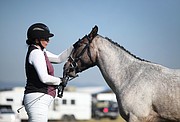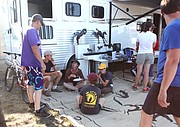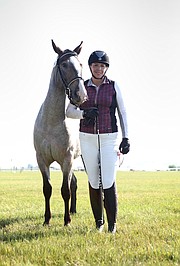Horse rescued from kill pen competes at The Event
Twisted Oliver, a 2-year-old Appaloosa, strutted around a grassy field at Rebecca Farm under the guise of his handler and owner, Michelle Donaldson. His multi-colored coat had been neatly trimmed and his black mane subdued into taut braids, ever bit as show-ready as his sole competitor, Dawn Gronlund’s Ferragamo CCSH.
Donaldson walked her gelding, affectionately known as Oliver, past a pair of judges who looked him up and down with a critical eye.
In the future event horse class, horses were evaluated on their potential to succeed in the sport of eventing — the equine equivalent of a triathlon.
Could he handle the quiet discipline of dressage, the unpredictable nature of a cross-country course or the demanding height of show jumping?
Most of all: Did he have a future in the sport?
Donaldson was sure of it.
But not long ago, it was uncertain whether Oliver would have any future at all.
He was one of more than 50 horses rescued from slaughter by a group of determined Montana horsewomen, dubbed JMG Rescue Horses, last October.
Thanks to the efforts of Donaldson, Krissta Rexin, Jeanne Gaudreau and Stevie Gaudreau, Oliver and his compatriots were given a second chance — to date, all but two have found new homes.
It all started last fall when Donaldson spotted a post on Facebook with photos of horses awaiting slaughter at a Washington kill pen. The first equine in the series happened to be an Appaloosa, which pulled at her heart strings. She had a horse of the same breed back home in Livingston.
She couldn’t just sit back and do nothing.
“My husband, per usual is like, ‘You can’t save all of them — you can’t have another horse,’” Donaldson said. “Of course, I don’t listen.”
She purchased Oliver and another Appaloosa for about $500 each from a kill buyer in Sunnyside, Washington. It’s the kill buyer’s job to visit horse auctions and purchase unwanted animals for as little as possible. From there, the animals are transported to a feed lot and then to a slaughterhouse. An estimated 100,000 American horses are shipped to slaughterhouses in Mexico and Canada each year according to the Humane Society of the United States.
“There are a ton of really good horses, through no fault of their own, end up in the kill pen,” Donaldson said. “Horses are happiest when they have a job, so our goal is to find a home and a job for every horse. And some horses jobs are just to be a pasture pet and that’s fine. Oliver’s job is to be an event horse.”
After purchasing two rescues of her own, Donaldson and the other members of JMG Rescue Horses were motivated to find homes for more.
Madeline Kurz, of Missoula, said she channeled her “grief energy” from losing her horse, Moose, in a freak accident, to the rescue effort. Moose was Kurz’s dressage horse that she hoped to ride in competition. But one afternoon, Moose injured her leg, and though she was initially poised to recover, she simply laid down one day and never got back up.
“She would lay her head on my lap and just sleep. I read her the entire book of Black Beauty,” Kurz said. “We had all that grief energy after Moose died, and we started networking these horses and sharing them. We were like let’s see how many we can get adopted, let’s see if we can fill a trailer.”
Kurz also took two rescues home — a paint and a thoroughbred.
But simply removing the horses from the pen wasn’t enough: first and foremost, they had to be quarantined. Diseases run rampant in kill pen environments, Donaldson said, and multiple rescues were afflicted with strangles — the equine equivalent of strep throat distinguished by secreting sores in the neck and face area.
Fellow adoptive horse mom Krissta Rexin said she wore a Tyvek suit to care for her adopted steeds to avoid transferring bacteria from the sick newcomers to her healthy herd. And Kurz braved minus 35-degree weather to keep a tab on her horses twice a day.
“This horse rescue stuff is not for the feint of heart,” Rexin said.
But after months of care and patience, horses like Oliver were able to begin a second life.
“If you’re looking for a good horse, don’t be afraid to look in the kill pen. There are lots of good horses that need homes,” Donaldson said. “The purpose of us bringing him here to show is to show people that even in the six months that he’s been out of the kill pen, and he’s only a 2-year-old, look what he can do.”
Oliver placed second at The Event at Rebecca Farm, and will show at the West Coast Championships held in Paso Robles, California. He earned his qualifying score and first-place finish in the 2-year-old division at the Arrowhead Horse Trials in Billings in June. Donaldson doesn’t want to stop there — she wants to ride and show Oliver someday in eventing competitions.
“The goal for Oliver is to be just like my big event horse,” she said. “We won’t start jumping until next year because he’s only two — you have to start slow and steady.”












